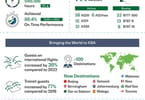WASHINGTON, DC – First-ever ranking of peace in the U.S. shows the nation has become more peaceful since 1995.
Report estimates reductions in violent crimes and incarceration rates to levels equal to Canada would yield $89 billion in direct savings, $272 billion in additional economic activity, and potentially create 2.7 million jobs.
New York, California and Texas see highest increases in peace since 1991, while North Dakota, South Dakota and Montana see largest declines.
Peace strongly correlated to 15 socioeconomic factors related to economic opportunity, education and health.
Peace is politically neutral – neither Republican nor Democratic states have an advantage.
Maine is the most peaceful U.S. state, while Louisiana is the least peaceful, based on results from the U.S. Peace Index (USPI), the first-ever ranking of the states on their levels of peace. The USPI will be released today in Washington, D.C.
The USPI, created by the Institute for Economics and Peace (IEP), an international think tank responsible for the annual Global Peace Index, revealed that peace in the United States improved by 8 percent from 1995 to 2009. This improvement was driven by a substantial decrease in rates of homicide and violent crime.
“I congratulate IEP on a meticulous, judicious and intriguing study of a vitally important topic,” said James K. Galbraith, Chair, Economists for Peace and Security, a UN-registered NGO, with an international network of thirteen affiliated organizations that promote economic analysis and appropriate action for peace, security and the world economy.
The Index, which defines peace as “the absence of violence,” looks at a set of five indicators, including homicide rates, violent crimes, percentage of the population in jail, number of police officers and availability of small arms (per 100,000 people) to rank the states. The data used to construct the Index is drawn from the Bureau of Justice Statistics, Federal Bureau of Investigation and Centers for Disease Control.
The Index provides each state with the estimated “total cost of violence,” which reflects the cost of correctional and policing services, judicial system and medical costs associated with violent crime and homicide, and lost productivity and wages.
The Institute for Economics and Peace estimates that at a time when states and lawmakers in Washington are struggling to balance budgets, reductions in violence, crime and incarcerations to the same levels as Canada would result in more than $360 billion in savings and additional economic activity.
This additional economic activity has the potential to create 2.7 million jobs, which would significantly reduce unemployment. Canada was chosen because of its close geographic proximity and similar level of economic development.
“Peace translates into dollars and cents,” said IEP Founder Steve Killelea. “We have seen this in the findings of the 2010 Global Peace Index, where we found that a 25 percent reduction in global violence would free up $1.8 trillion USD annually.”
“We are seeing the same thing with the USPI. By increasing peace, the United States can ensure that these unrealized billions are available to reduce taxes, stimulate the economy or invest in the nation’s infrastructure, schools, communities, and small businesses,” Killelea added. He noted that not only are incarceration rates a drag on the U.S. economy, but they also don’t necessarily equate to decreases in crime and violence, or an increase in a state’s peacefulness.
The USPI also found that a state’s ranking is strongly correlated with 15 socioeconomic factors, including high school graduation rates, infant mortality, access to basic services, labor force participation rates, and rates of poverty and teenage pregnancy. Meanwhile, factors such as median income and a state’s political affiliation had no discernable impact on a state’s level of peace.
“The Index underlines the negative impact of violence on our economy, and reinforces the idea that minimizing violence, through job creation programs and increased access to education and healthcare, dramatically increases the prospects for growth,” said Kerry Kennedy, President, Robert F. Kennedy Center for Justice and Human Rights.
“We should be mindful of this when proposing domestic discretionary spending cuts that will not only disproportionately impact those most vulnerable to violence and poverty, but will also hinder our collective prosperity,” Kennedy added.
Additional Findings:
The ten most peaceful states (from 1 to 10) are Maine, New Hampshire, Vermont, Minnesota, North Dakota, Utah, Massachusetts, Rhode Island, Iowa and Washington.
Maine was ranked first overall because it topped the list of states on three of the five USPI indicators: number of violent crimes, number of police officers and incarceration rate.
The ten least peaceful states (from 50 to 40) are Louisiana, Tennessee, Nevada, Florida, Alabama, Texas, Arkansas, Oklahoma, South Carolina and Maryland.
Regionally, southern states were identified as being the least peaceful, while states in the northeast were most peaceful. The peacefulness of states in the Midwest and West was about equal, with Midwest states being slightly more peaceful.
The total cost of violence per person in a state ranges from $656 in Maine to $2,458 in Louisiana. The USPI estimates that the economic effect of decreasing violence in states by 25 percent ranges from $126 million in Vermont to $16 billion in California.
New York experienced the most significant increase in peace, as a result of decreases in violent crime and homicide rates, simultaneously with a substantial decrease in incarceration rates.
Conversely, South Dakota saw the largest decline due to a steady rise in incarcerations and the number of police without a fall in the homicide and violent crime rates.
Washington, D.C. is excluded from the USPI as incarceration data for the District is not available post 2002.
To download the U.S. Peace Index and explore the full rankings visit http://www.visionofhumanity.org.
WHAT TO TAKE AWAY FROM THIS ARTICLE:
- The Institute for Economics and Peace estimates that at a time when states and lawmakers in Washington are struggling to balance budgets, reductions in violence, crime and incarcerations to the same levels as Canada would result in more than $360 billion in savings and additional economic activity.
- The USPI, created by the Institute for Economics and Peace (IEP), an international think tank responsible for the annual Global Peace Index, revealed that peace in the United States improved by 8 percent from 1995 to 2009.
- “The Index underlines the negative impact of violence on our economy, and reinforces the idea that minimizing violence, through job creation programs and increased access to education and healthcare, dramatically increases the prospects for growth,”.






















